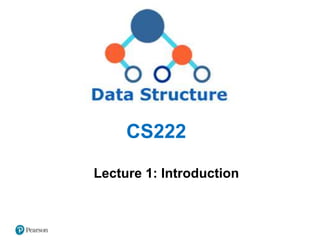
Lecture 1.pptx
- 2. Objectives To define data structures and explain their importance To differentiate between data structures and databases To summarize the concepts of : Arrays and Multidimension Arrays Stack Queue Linked List Tree Graph
- 3. Introduction “ Get your data structures correct first, and the rest of the program will write itself.” - David Jones Program = Data Structures + Algorithms
- 4. Definition A data structure is a way of organizing and storing data in a computer system or memory to enable efficient operations, such as data retrieval, insertion, deletion, and manipulation. It provides a logical and systematic arrangement of data elements, along with relationships and operations defined on those elements. Data structures serve as the foundation for designing algorithms and solving problems in various domains of computer science and programming.
- 5. Importance Efficient Data Organization: Data structures provide efficient organization and storage mechanisms for managing and manipulating large volumes of data. Fast Data Access: Well-designed data structures enable quick and direct access to specific data elements, enhancing performance and reducing retrieval time. Optimal Memory Utilization: Data structures help in optimizing memory usage by minimizing memory overhead and providing efficient allocation and deallocation of resources.
- 6. Importance Algorithm Design: Data structures are the building blocks for designing efficient algorithms and solving complex computational problems. Code Maintainability: Properly designed data structures enhance code maintainability by providing clear and organized ways to manage and access data, making it easier for developers to understand and modify code. Search and Retrieval Efficiency: Certain data structures, such as binary search trees and hash tables, offer efficient search and retrieval operations, reducing time complexity.
- 7. Importance Sorting and Sorting Algorithms: Data structures facilitate sorting operations by providing efficient algorithms like quicksort, merge sort, and heapsort. Code Reusability: By implementing common data structures, developers can reuse code and leverage existing libraries, saving time and effort in application development. Scalability and Performance: Properly chosen data structures contribute to scalable and high-performance systems, handling increasing data loads efficiently.
- 8. Importance Problem Solving and Software Engineering: A solid understanding of data structures is crucial for effective problem-solving and designing robust software applications. Dynamic Data Handling: Dynamic data structures, such as dynamic arrays and linked lists, adapt to changing data sizes, providing flexibility and efficient memory usage. Data Compression: Certain data structures, such as Huffman trees, facilitate data compression techniques, reducing storage space and improving data transmission.
- 9. Data Structures vs. Databases
- 10. Types of Data Struct 1. Array 2. Linked List 3. Stack 4. Queue 5. Tree 6. Graph 7. Hash Table 8. Heap 9. Trie 10. Matrix 11. Set 12. Dictionary 13. Priority Queue 14. Disjoint Set 15. Bloom Filter 16. Red-Black Tree 17. B-tree 18. Sparse Matrix 19. Circular Buffer 20. Graph Adjacency List
- 11. Array Short Description: An array is a contiguous block of memory that stores a fixed-size sequence of elements of the same type. Sample Applications: Sorting Algorithms Search Algorithms Counting and Frequency Analysis
- 12. Multidimensional Array Short Description: A multidimensional array is an array with multiple dimensions, such as 2D or 3D arrays. Sample Applications: Storing and manipulating images or matrices in image processing and scientific computations. Implementing game boards or grids for games and simulations. Representing tabular data in a spreadsheet or database.
- 13. Stack Short Description: A stack is a Last-In-First-Out (LIFO) data structure that stores elements in a sequential manner, allowing insertion and deletion only at one end. Sample Applications: Function call stack in programming languages for managing program execution and memory allocation. Undo/Redo functionality in text editors or graphic design software. Depth-first search algorithm implementation in graph traversal.
- 14. Queue Short Description: A queue is a First-In-First-Out (FIFO) data structure that stores elements in a sequential manner, allowing insertion at one end and deletion at the other end. Sample Applications: Print spooling, where print jobs are queued and processed in the order they are submitted. Process scheduling in operating systems Message queuing systems for reliable message delivery in distributed systems.
- 15. Linked List Short Description: A linked list is a linear data structure consisting of nodes that contain data and a reference to the next node, forming a sequence. Sample Applications: Implementing a stack or queue using a linked list as the underlying data structure. Managing dynamic data structures like memory allocation in operating systems. Implementing sparse matrices or sparse data structures to optimize memory usage.
- 16. Tree Short Description: A tree is a hierarchical data structure composed of nodes connected by edges, with a root node at the top and child nodes branching out from it. Sample Applications: Representing file systems, where directories and subdirectories are organized hierarchically. Implementing binary search trees for efficient searching and sorting. Parsing and evaluating mathematical expressions using expression trees.
- 17. Graph Short Description: A graph is a collection of vertices (nodes) connected by edges, representing relationships or connections between entities. Sample Applications: Social network analysis, where individuals and their connections are represented by vertices and edges. Routing algorithms in transportation networks or computer networks. Image recognition and object detection using graph-based models like convolutional neural networks.
- 18. CS222 End of Lecture 1 Next Lecture: Arrays